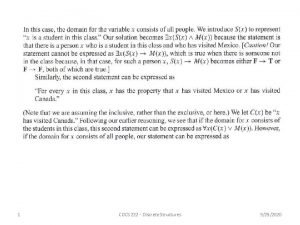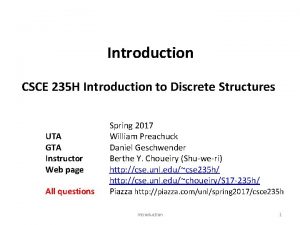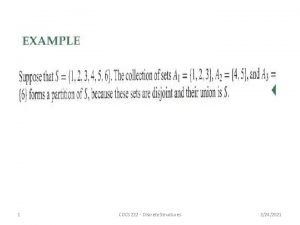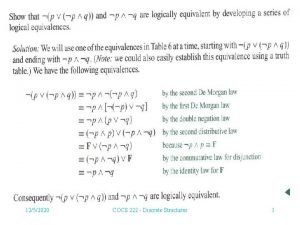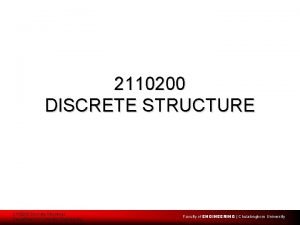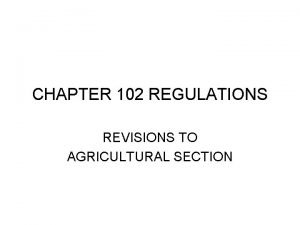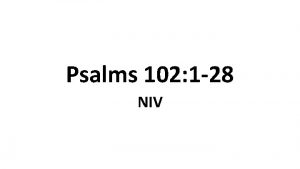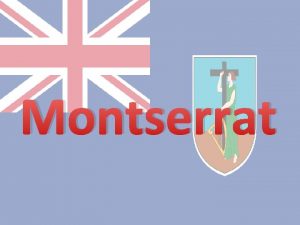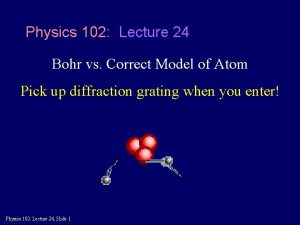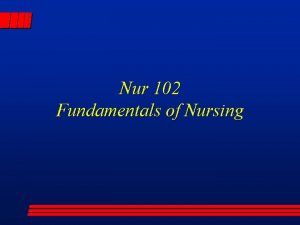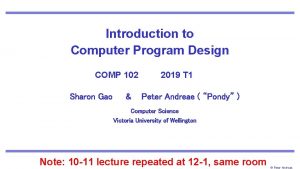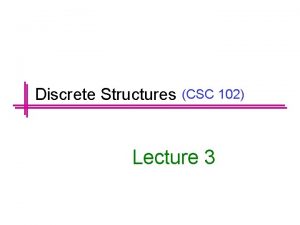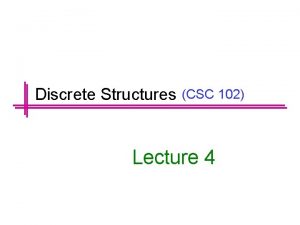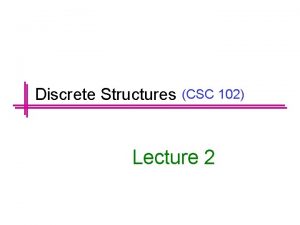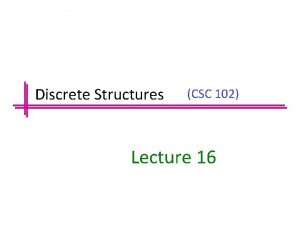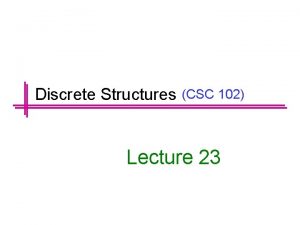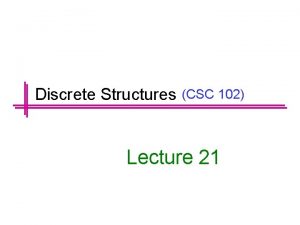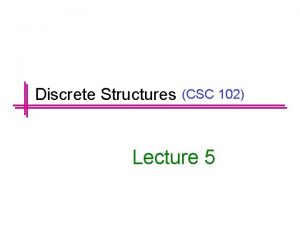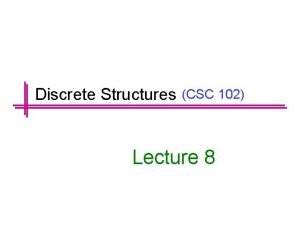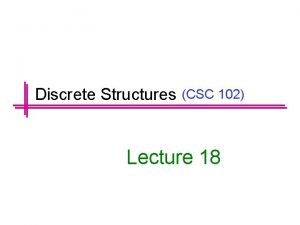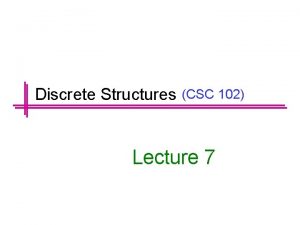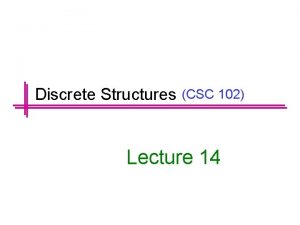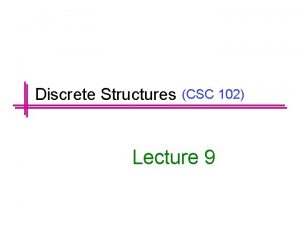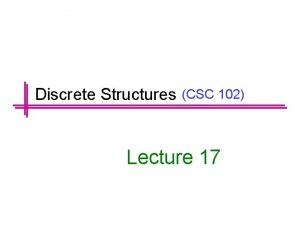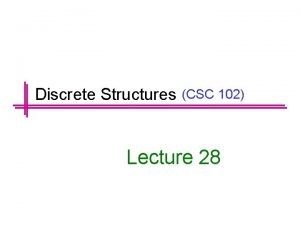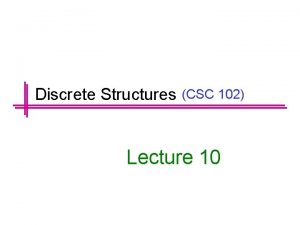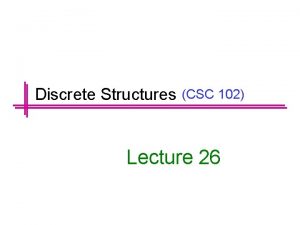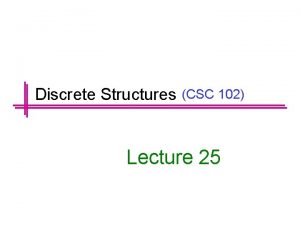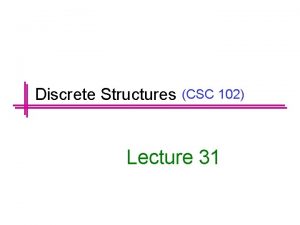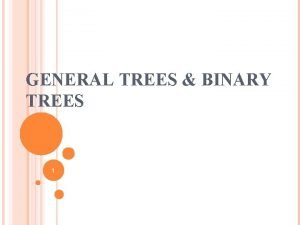Discrete Structures CSC 102 Lecture 32 Trees Previous





























- Slides: 29

Discrete Structures (CSC 102) Lecture 32

Trees

Previous Lecture v Matrices and Graphs v Matrices and Directed Graphs v Matrices and undirected Graphs v Matrices and Connected Components v Trees v Characterizing Trees v Rooted Trees

Today’s Lecture v Rooted Trees v Binary Trees v Spanning Trees and Shortest Paths v Minimum Spanning Trees v Kruskal’s Algorithm v Prim’s Algorithm v Finding Minimum Spanning Trees

Rooted Trees

Rooted Trees These terms are illustrated in the following Figure of Rooted Tree

Rooted Trees Example

Binary Trees

Representation of Algebraic Expressions a/b ((a − b)·c) + (d/e) a/(c+d)

Spanning Trees and Shortest Paths An East Coast airline company wants to expand service to the Midwest and has received permission from the Federal Aviation Authority to fly any of the routes shown in Figure

Spanning Trees and Shortest Paths The fact is that the graph of any system of routes that satisfies the company’s wishes is a tree, because if the graph were to contain a circuit, then one of the routes in the circuit could be removed without disconnecting the graph, and that would give a smaller total number of routes. But any tree with eight vertices has seven edges. Therefore, any system of routes that connects all eight vertices and yet minimizes the total number of routes consists of seven routes.

Spanning Trees and Shortest Paths Definition A spanning tree for a graph G is a subgraph of G that contains every vertex of G and is a tree. Theorem 1. Every connected graph has a spanning tree. 2. Any two spanning trees for a graph have the same number of edges.

Spanning Trees Example Find all spanning trees for the graph G pictured below. Solution The graph G has one circuit v 2 v 1 v 4 v 2, and removal of any edge of the circuit gives a tree. Thus, as shown below, there are three spanning trees for G.

Minimum Spanning Trees Now suppose the airline company wants to serve all the cities shown, but with a route system that minimizes the total mileage. More generally, a graph whose edges are labeled with numbers (known as weights) is called a weighed graph. A minimum-weight spanning tree, or simply a minimum spanning tree, is a spanning tree for which the sum of the weights of all the edges is as small as possible.

Minimum Spanning Trees

Kruskal’s Algorithm In Kruskal’s algorithm, the edges of a connected weighted graph are examined one by Courtesy of Joseph Kruskal (born 1928) one in order of increasing weight. At each stage the edge being examined is added to what will become the minimum spanning tree, provided that this addition does not create a circuit. After n − 1 edges have been added (where n is the number of vertices of the graph), these edges, together with the vertices of the graph, form a minimum spanning tree for the graph.

Kruskal’s Algorithm

Kruskal’s Algorithm Describe the action of Kruskal’s algorithm on the graph shown in Figure, where n = 8.

Kruskal’s Algorithm

Kruskal’s Algorithm

Prim’s Algorithm Prim’s algorithm works differently from Kruskal’s. It builds a minimum spanning tree T Courtesy of Alcatel. Lucent Technologies Robert Prim (born 1921) by expanding outward in connected links from some vertex. One edge and one vertex are added at each stage. The edge added is the one of least weight that connects the vertices already in T with those not in T , and the vertex is the endpoint of this edge that is not already in T.

Prim’s Algorithm

Prim’s Algorithm Describe the action of Prim’s algorithm for the graph in Figure using the Minneapolis vertex as a starting point.

Prim’s Algorithm

Finding Minimum Spanning Trees Example Find all minimum spanning trees for the following graph. Use Kruskal’s algorithm and Prim’s algorithm starting at vertex a. Indicate the order in which edges are added to form each tree. Solution When Kruskal’s algorithm is applied, edges are added in one of the following two orders:

Finding Minimum Spanning Trees When Prim’s algorithm is applied starting at a, edges are added in one of the following two orders: Thus, as shown below, there are two distinct minimum spanning trees for this graph.

Lecture Summary v Rooted Trees v Binary Trees v Spanning Trees and Shortest Paths v Minimum Spanning Trees v Kruskal’s Algorithm v Prim’s Algorithm v Finding Minimum Spanning Trees

Syllabus (Topics to be covered in this course) • • • Logic Elementary Number Theory and Methods of Proof Set Theory Relations Sequences and Summation Mathematical Induction Counting Relations and Equivalence Relations Graphs Trees

Reference Books • Discrete Mathematics and its Applications (with Combinatorics and Graph Theory) 6 th Edition, The Mc. Graw-Hill Companies, 2007, Kenneth H. Rosen. • Discrete Mathematics with Applications 2 nd Edition, Thomson Learning, 1995, Susanna S. Epp. • Discrete Mathematics for Computer Scientists 2 nd Edition, Addison-Wesley, 1999, John Truss.
 Csc 102
Csc 102 01:640:244 lecture notes - lecture 15: plat, idah, farad
01:640:244 lecture notes - lecture 15: plat, idah, farad Discrete structures
Discrete structures Discrete math
Discrete math Discrete structures
Discrete structures Discrete computational structures
Discrete computational structures Mathematics 1
Mathematics 1 Discrete structures
Discrete structures 2110200
2110200 Homologous structures examples
Homologous structures examples Fitness chapter 102
Fitness chapter 102 Nur 102
Nur 102 Psalm 102:1-4
Psalm 102:1-4 Area 102
Area 102 Nur 102
Nur 102 Kmvss 102
Kmvss 102 102 graphic
102 graphic Convenio 102 oit
Convenio 102 oit Aljalal phys 102
Aljalal phys 102 101012 bằng
101012 bằng Quest soft
Quest soft 657 sayılı kanun 102. madde
657 sayılı kanun 102. madde Legea nr. 102/2020
Legea nr. 102/2020 Funksjonsutrykk
Funksjonsutrykk 102 graphic
102 graphic Physics 102
Physics 102 Nur 102
Nur 102 102 graphic
102 graphic Comp 102
Comp 102 Egee 102 home activity 4
Egee 102 home activity 4


